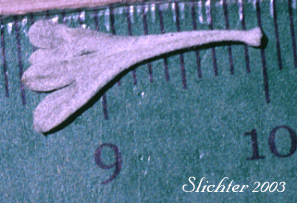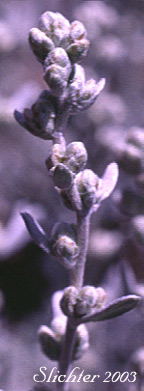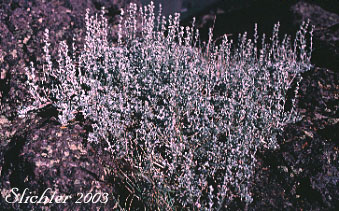 An
individual leaf from low sagebrush (ssp. arbuscula). Note the triangular shape of the bladewhich
tapers to the petiole, the shallow lobes at the tip, and the dense covering of
whitish hairs. Photographed on the rim above Kiger Gorge and Mosquito Creek on
the Steens Mt..........July 17, 2000.
An
individual leaf from low sagebrush (ssp. arbuscula). Note the triangular shape of the bladewhich
tapers to the petiole, the shallow lobes at the tip, and the dense covering of
whitish hairs. Photographed on the rim above Kiger Gorge and Mosquito Creek on
the Steens Mt..........July 17, 2000.
Low sagebrush is sometims known as scabland sagebrush. It is a low, densely gray-haired shrub with a pungent sagebrush taste and odor from 10-40 cm high. It is often spreading at the base with numerous erect, leafy shots rising upwards. The leaves range from 1-4 cm long (typically 1.5 cm long or less) with 3-5 shallow to deeply cleft, broad segments (See photo at right.). The blades are wedge-shaped, or triangular, with the broadest segment at the distal end. The leaves of the upper stems are often linear to lanceolate in shape with entire margins, lacking the thin lobed segments.
The inflorescence is a congested, narrow spike rarely more than 1.5 cm wide. The narrow involucre ranges from 3-5 mm highand 3-4 mm wide, with the middle and outer bracts covered with dense, white hairs. The flower heads are discoid, with 4-15 flowers per head. Low sagebrush flowers from June to September.
ssp. arbuscula -
ssp. longicaulis -
ssp. thermopola -
Habitat:
Low sagebrush may be found in shallow soils on dry, rocky sites in the plains and foothills. It may be found to elevations as high as 3300 meters.
Low sagebrush may be found to the east of the Cascade Mts. from central Washington and central Oregon south to California and east through Idaho to western Montana, western Wyoming, northern Colorado, Utah and Nevada.

